Employee Engagement in Successful Restaurant Businesses Dissertation
VerifiedAdded on 2022/09/07
|27
|6770
|15
Project
AI Summary
This dissertation proposal investigates the influence of employee engagement on the success of restaurant businesses, focusing on a Maryland-based establishment operating for over five years. The study addresses the high failure rates in the restaurant industry, proposing that employee engagement is a crucial factor often overlooked. It aims to determine if successful restaurants utilize employee engagement strategies, employing the Employee Engagement Scorecard Model, surveys, and interviews for primary data collection, supplemented by secondary data from existing literature. The research seeks to answer questions about the impact of employee engagement on restaurant success and whether Maryland restaurants use this approach. The study's theoretical framework is rooted in the understanding that employee engagement, involving two-way communication, is vital for improving worker attitudes and, consequently, service quality. The research anticipates findings that demonstrate a correlation between employee engagement and business success in the restaurant sector.
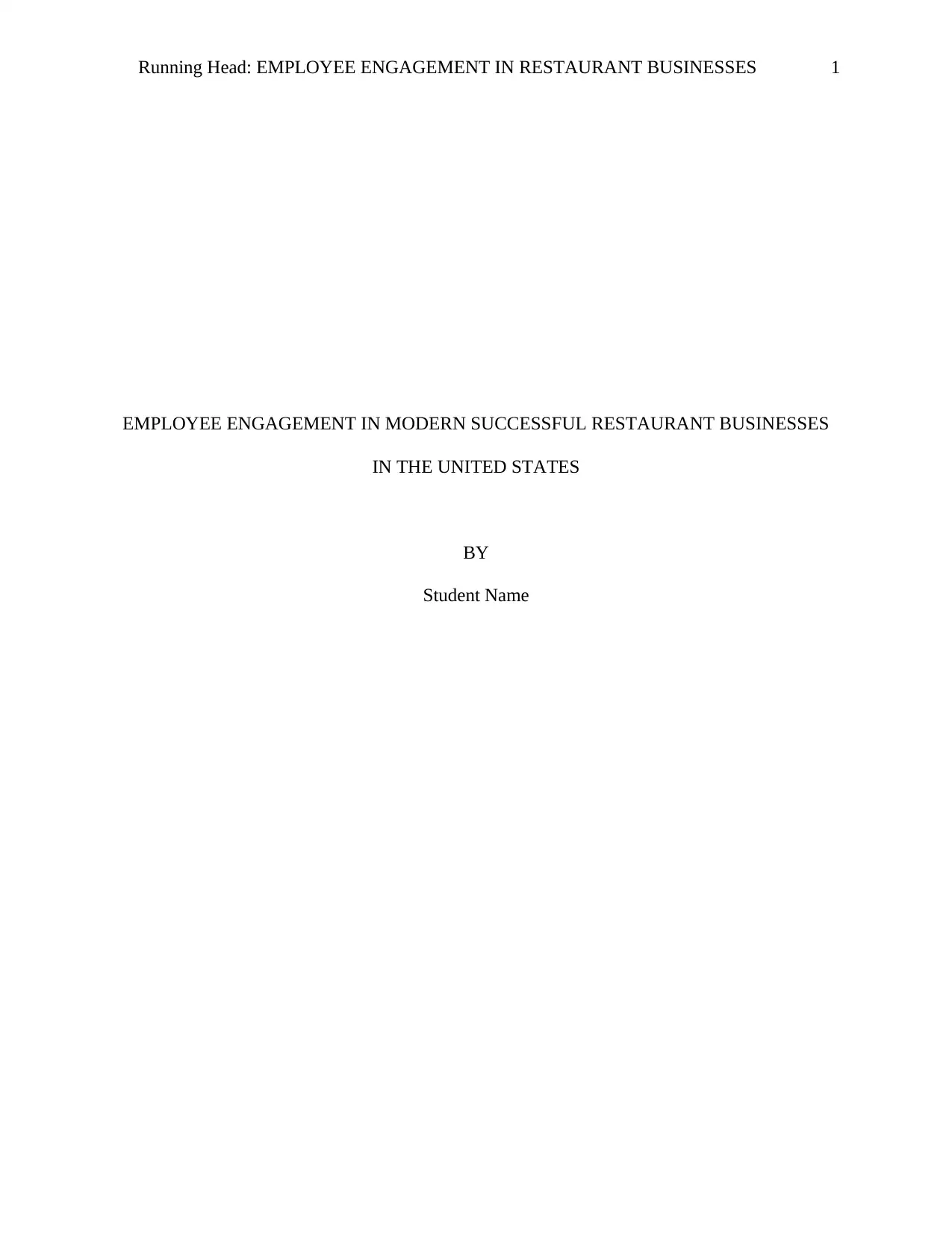
Running Head: EMPLOYEE ENGAGEMENT IN RESTAURANT BUSINESSES 1
EMPLOYEE ENGAGEMENT IN MODERN SUCCESSFUL RESTAURANT BUSINESSES
IN THE UNITED STATES
BY
Student Name
EMPLOYEE ENGAGEMENT IN MODERN SUCCESSFUL RESTAURANT BUSINESSES
IN THE UNITED STATES
BY
Student Name
Paraphrase This Document
Need a fresh take? Get an instant paraphrase of this document with our AI Paraphraser
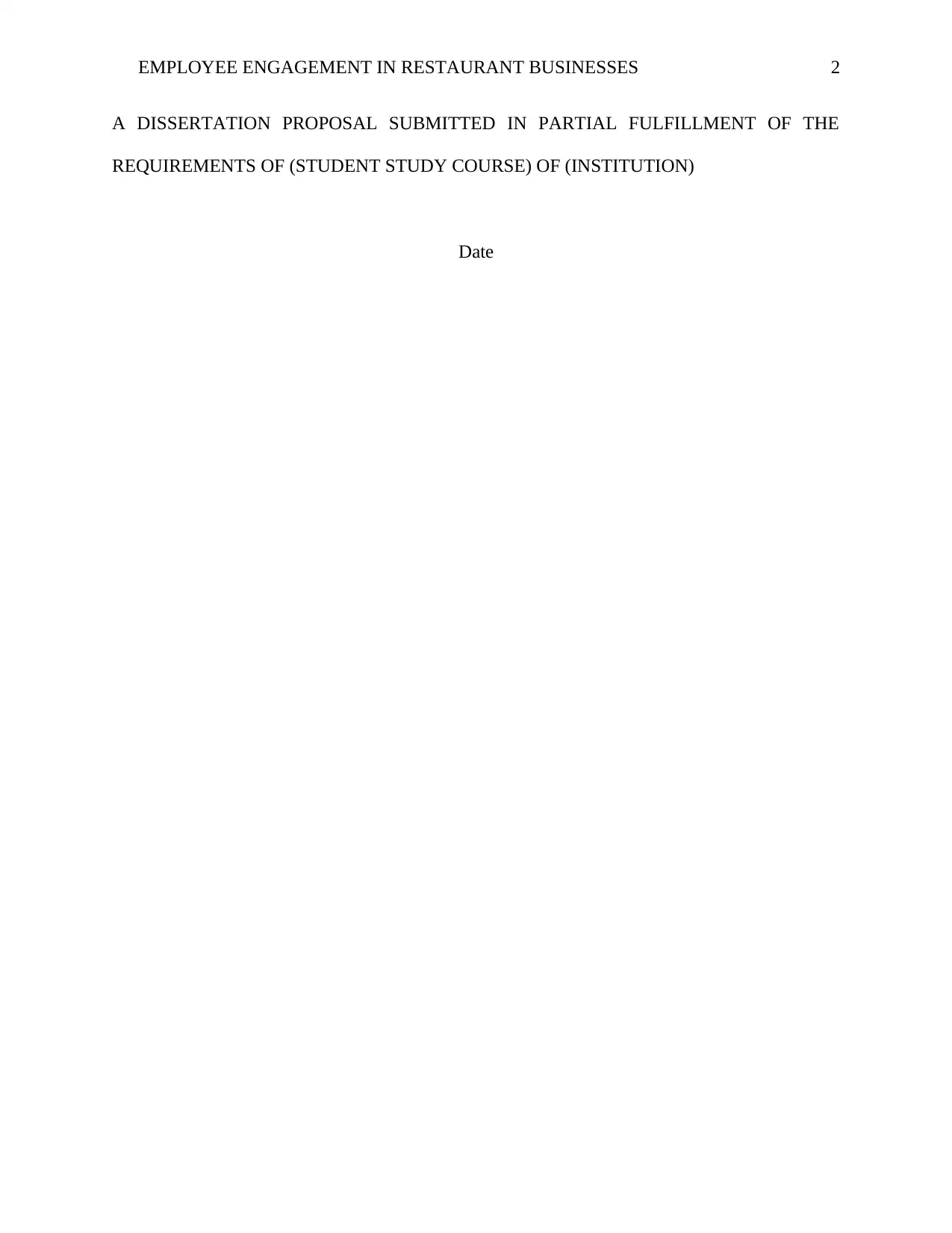
EMPLOYEE ENGAGEMENT IN RESTAURANT BUSINESSES 2
A DISSERTATION PROPOSAL SUBMITTED IN PARTIAL FULFILLMENT OF THE
REQUIREMENTS OF (STUDENT STUDY COURSE) OF (INSTITUTION)
Date
A DISSERTATION PROPOSAL SUBMITTED IN PARTIAL FULFILLMENT OF THE
REQUIREMENTS OF (STUDENT STUDY COURSE) OF (INSTITUTION)
Date
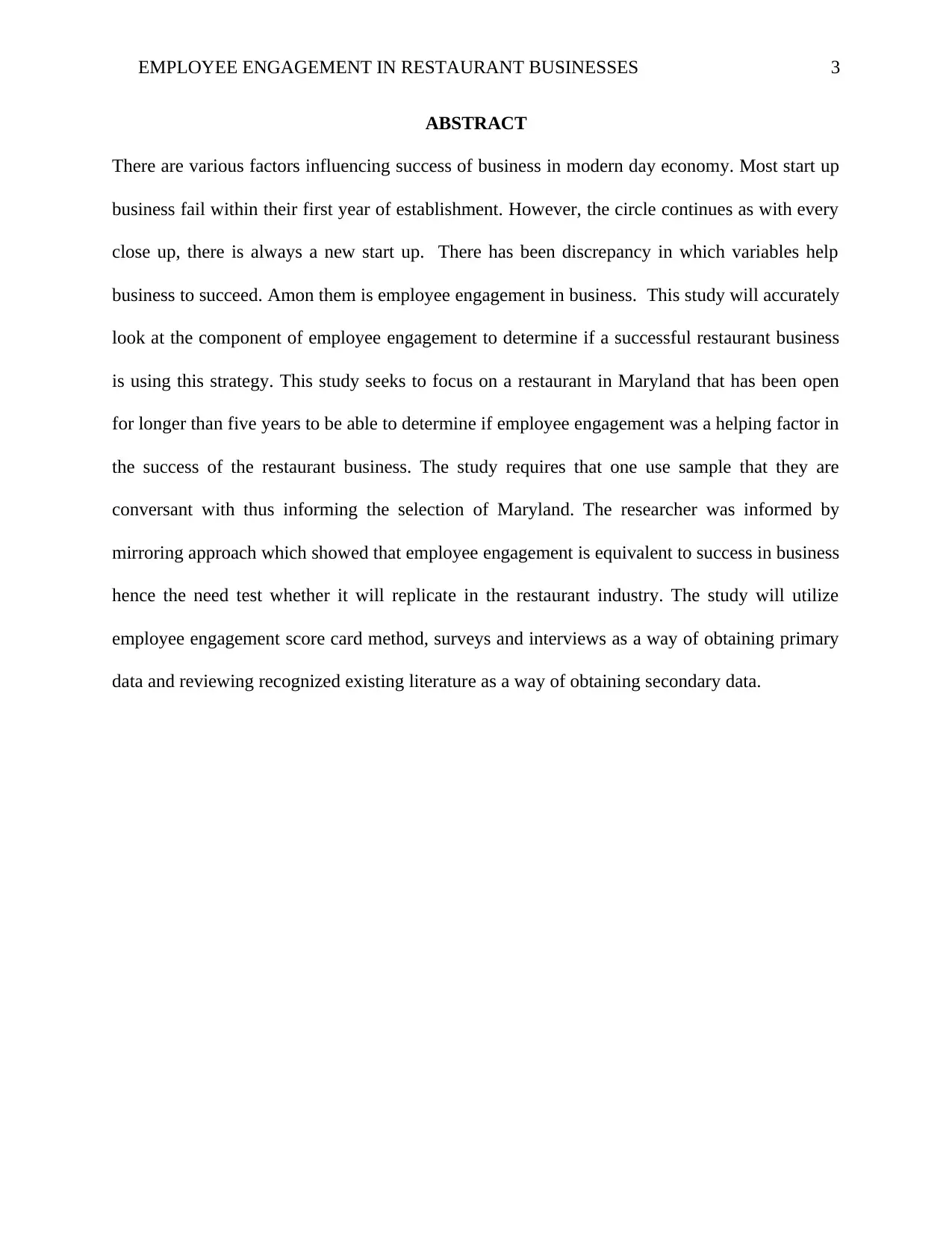
EMPLOYEE ENGAGEMENT IN RESTAURANT BUSINESSES 3
ABSTRACT
There are various factors influencing success of business in modern day economy. Most start up
business fail within their first year of establishment. However, the circle continues as with every
close up, there is always a new start up. There has been discrepancy in which variables help
business to succeed. Amon them is employee engagement in business. This study will accurately
look at the component of employee engagement to determine if a successful restaurant business
is using this strategy. This study seeks to focus on a restaurant in Maryland that has been open
for longer than five years to be able to determine if employee engagement was a helping factor in
the success of the restaurant business. The study requires that one use sample that they are
conversant with thus informing the selection of Maryland. The researcher was informed by
mirroring approach which showed that employee engagement is equivalent to success in business
hence the need test whether it will replicate in the restaurant industry. The study will utilize
employee engagement score card method, surveys and interviews as a way of obtaining primary
data and reviewing recognized existing literature as a way of obtaining secondary data.
ABSTRACT
There are various factors influencing success of business in modern day economy. Most start up
business fail within their first year of establishment. However, the circle continues as with every
close up, there is always a new start up. There has been discrepancy in which variables help
business to succeed. Amon them is employee engagement in business. This study will accurately
look at the component of employee engagement to determine if a successful restaurant business
is using this strategy. This study seeks to focus on a restaurant in Maryland that has been open
for longer than five years to be able to determine if employee engagement was a helping factor in
the success of the restaurant business. The study requires that one use sample that they are
conversant with thus informing the selection of Maryland. The researcher was informed by
mirroring approach which showed that employee engagement is equivalent to success in business
hence the need test whether it will replicate in the restaurant industry. The study will utilize
employee engagement score card method, surveys and interviews as a way of obtaining primary
data and reviewing recognized existing literature as a way of obtaining secondary data.
⊘ This is a preview!⊘
Do you want full access?
Subscribe today to unlock all pages.

Trusted by 1+ million students worldwide
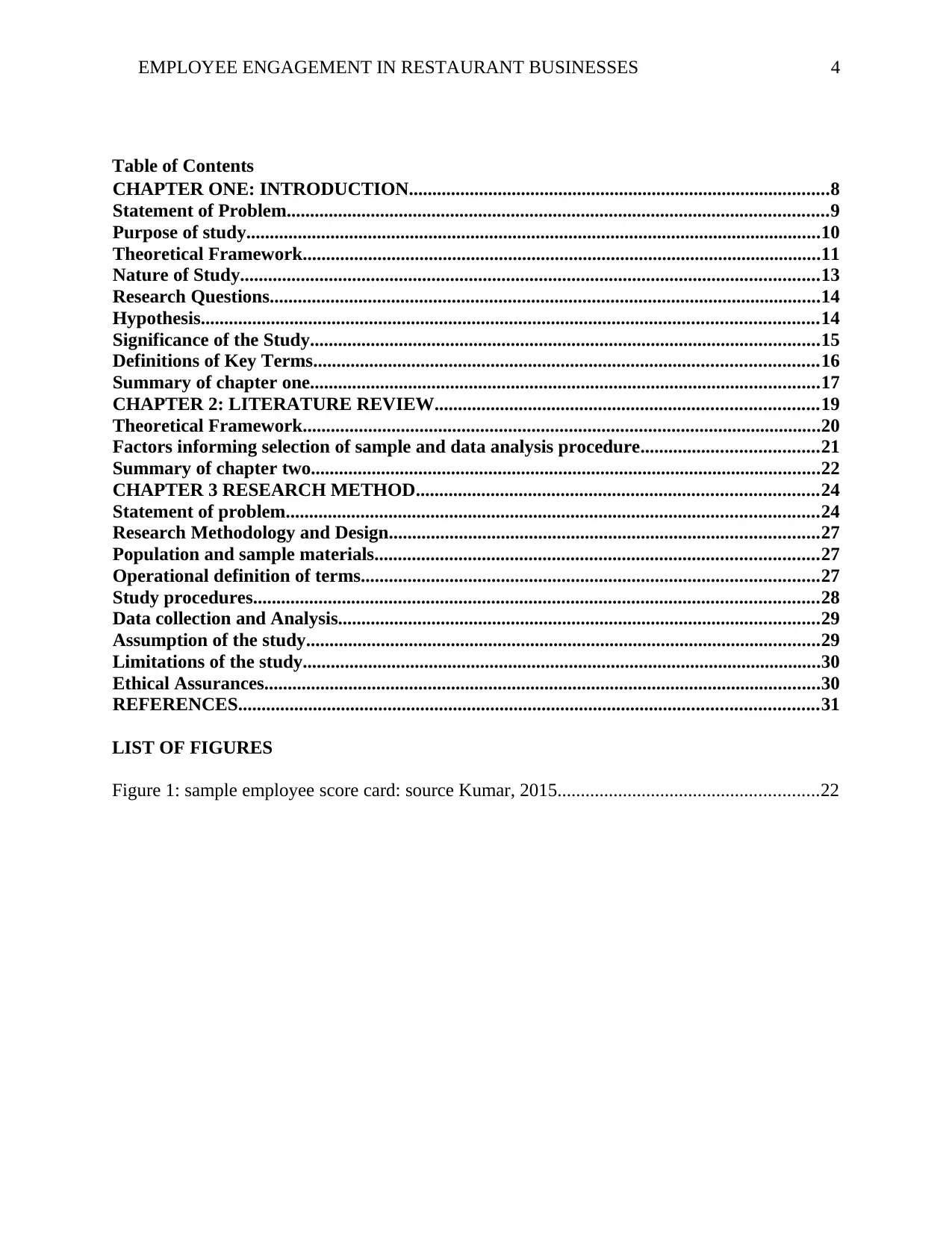
EMPLOYEE ENGAGEMENT IN RESTAURANT BUSINESSES 4
Table of Contents
CHAPTER ONE: INTRODUCTION..........................................................................................8
Statement of Problem....................................................................................................................9
Purpose of study...........................................................................................................................10
Theoretical Framework...............................................................................................................11
Nature of Study............................................................................................................................13
Research Questions......................................................................................................................14
Hypothesis....................................................................................................................................14
Significance of the Study.............................................................................................................15
Definitions of Key Terms............................................................................................................16
Summary of chapter one.............................................................................................................17
CHAPTER 2: LITERATURE REVIEW..................................................................................19
Theoretical Framework...............................................................................................................20
Factors informing selection of sample and data analysis procedure......................................21
Summary of chapter two.............................................................................................................22
CHAPTER 3 RESEARCH METHOD......................................................................................24
Statement of problem..................................................................................................................24
Research Methodology and Design............................................................................................27
Population and sample materials...............................................................................................27
Operational definition of terms..................................................................................................27
Study procedures.........................................................................................................................28
Data collection and Analysis.......................................................................................................29
Assumption of the study..............................................................................................................29
Limitations of the study...............................................................................................................30
Ethical Assurances.......................................................................................................................30
REFERENCES............................................................................................................................31
LIST OF FIGURES
Figure 1: sample employee score card: source Kumar, 2015........................................................22
Table of Contents
CHAPTER ONE: INTRODUCTION..........................................................................................8
Statement of Problem....................................................................................................................9
Purpose of study...........................................................................................................................10
Theoretical Framework...............................................................................................................11
Nature of Study............................................................................................................................13
Research Questions......................................................................................................................14
Hypothesis....................................................................................................................................14
Significance of the Study.............................................................................................................15
Definitions of Key Terms............................................................................................................16
Summary of chapter one.............................................................................................................17
CHAPTER 2: LITERATURE REVIEW..................................................................................19
Theoretical Framework...............................................................................................................20
Factors informing selection of sample and data analysis procedure......................................21
Summary of chapter two.............................................................................................................22
CHAPTER 3 RESEARCH METHOD......................................................................................24
Statement of problem..................................................................................................................24
Research Methodology and Design............................................................................................27
Population and sample materials...............................................................................................27
Operational definition of terms..................................................................................................27
Study procedures.........................................................................................................................28
Data collection and Analysis.......................................................................................................29
Assumption of the study..............................................................................................................29
Limitations of the study...............................................................................................................30
Ethical Assurances.......................................................................................................................30
REFERENCES............................................................................................................................31
LIST OF FIGURES
Figure 1: sample employee score card: source Kumar, 2015........................................................22
Paraphrase This Document
Need a fresh take? Get an instant paraphrase of this document with our AI Paraphraser
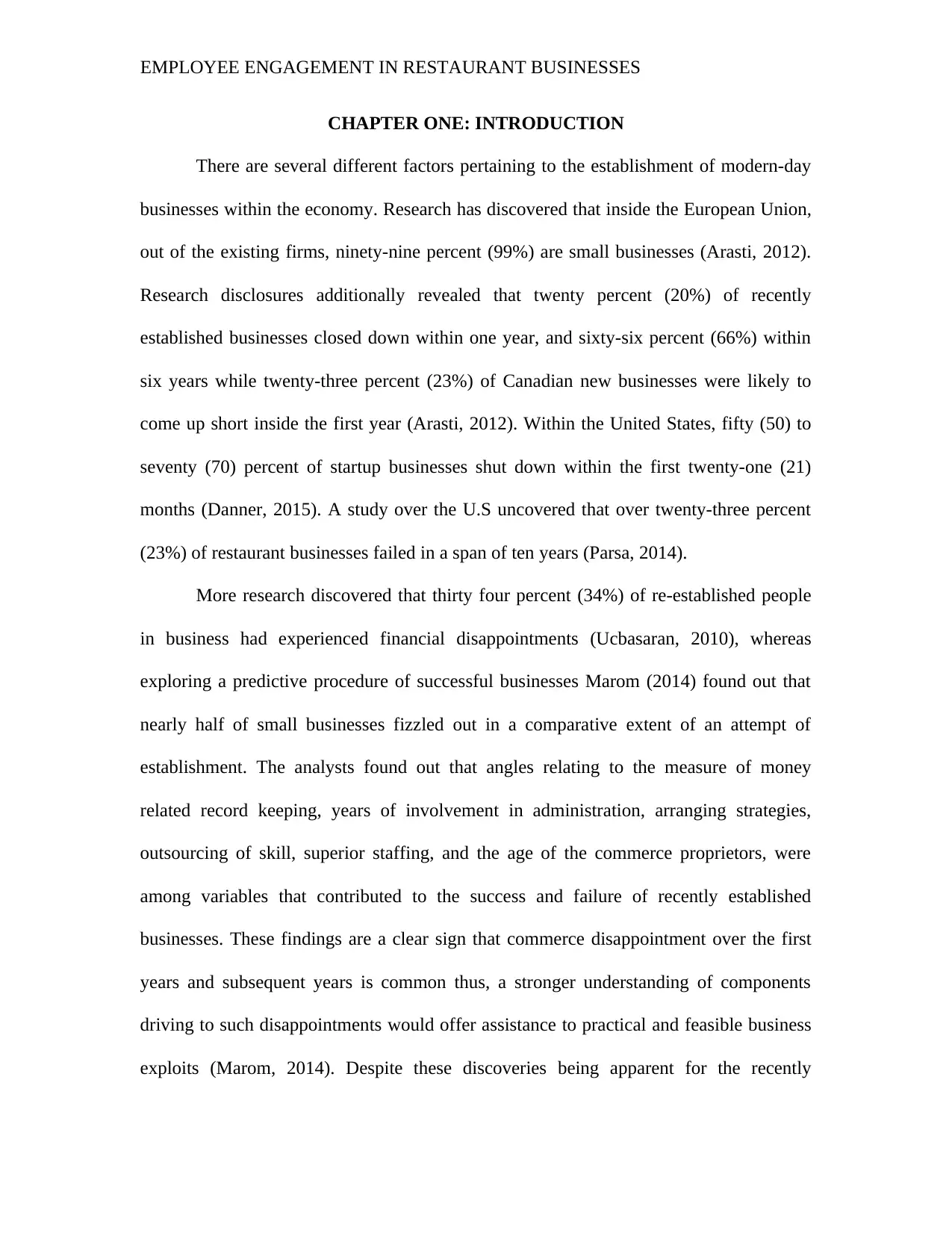
EMPLOYEE ENGAGEMENT IN RESTAURANT BUSINESSES
CHAPTER ONE: INTRODUCTION
There are several different factors pertaining to the establishment of modern-day
businesses within the economy. Research has discovered that inside the European Union,
out of the existing firms, ninety-nine percent (99%) are small businesses (Arasti, 2012).
Research disclosures additionally revealed that twenty percent (20%) of recently
established businesses closed down within one year, and sixty-six percent (66%) within
six years while twenty-three percent (23%) of Canadian new businesses were likely to
come up short inside the first year (Arasti, 2012). Within the United States, fifty (50) to
seventy (70) percent of startup businesses shut down within the first twenty-one (21)
months (Danner, 2015). A study over the U.S uncovered that over twenty-three percent
(23%) of restaurant businesses failed in a span of ten years (Parsa, 2014).
More research discovered that thirty four percent (34%) of re-established people
in business had experienced financial disappointments (Ucbasaran, 2010), whereas
exploring a predictive procedure of successful businesses Marom (2014) found out that
nearly half of small businesses fizzled out in a comparative extent of an attempt of
establishment. The analysts found out that angles relating to the measure of money
related record keeping, years of involvement in administration, arranging strategies,
outsourcing of skill, superior staffing, and the age of the commerce proprietors, were
among variables that contributed to the success and failure of recently established
businesses. These findings are a clear sign that commerce disappointment over the first
years and subsequent years is common thus, a stronger understanding of components
driving to such disappointments would offer assistance to practical and feasible business
exploits (Marom, 2014). Despite these discoveries being apparent for the recently
CHAPTER ONE: INTRODUCTION
There are several different factors pertaining to the establishment of modern-day
businesses within the economy. Research has discovered that inside the European Union,
out of the existing firms, ninety-nine percent (99%) are small businesses (Arasti, 2012).
Research disclosures additionally revealed that twenty percent (20%) of recently
established businesses closed down within one year, and sixty-six percent (66%) within
six years while twenty-three percent (23%) of Canadian new businesses were likely to
come up short inside the first year (Arasti, 2012). Within the United States, fifty (50) to
seventy (70) percent of startup businesses shut down within the first twenty-one (21)
months (Danner, 2015). A study over the U.S uncovered that over twenty-three percent
(23%) of restaurant businesses failed in a span of ten years (Parsa, 2014).
More research discovered that thirty four percent (34%) of re-established people
in business had experienced financial disappointments (Ucbasaran, 2010), whereas
exploring a predictive procedure of successful businesses Marom (2014) found out that
nearly half of small businesses fizzled out in a comparative extent of an attempt of
establishment. The analysts found out that angles relating to the measure of money
related record keeping, years of involvement in administration, arranging strategies,
outsourcing of skill, superior staffing, and the age of the commerce proprietors, were
among variables that contributed to the success and failure of recently established
businesses. These findings are a clear sign that commerce disappointment over the first
years and subsequent years is common thus, a stronger understanding of components
driving to such disappointments would offer assistance to practical and feasible business
exploits (Marom, 2014). Despite these discoveries being apparent for the recently
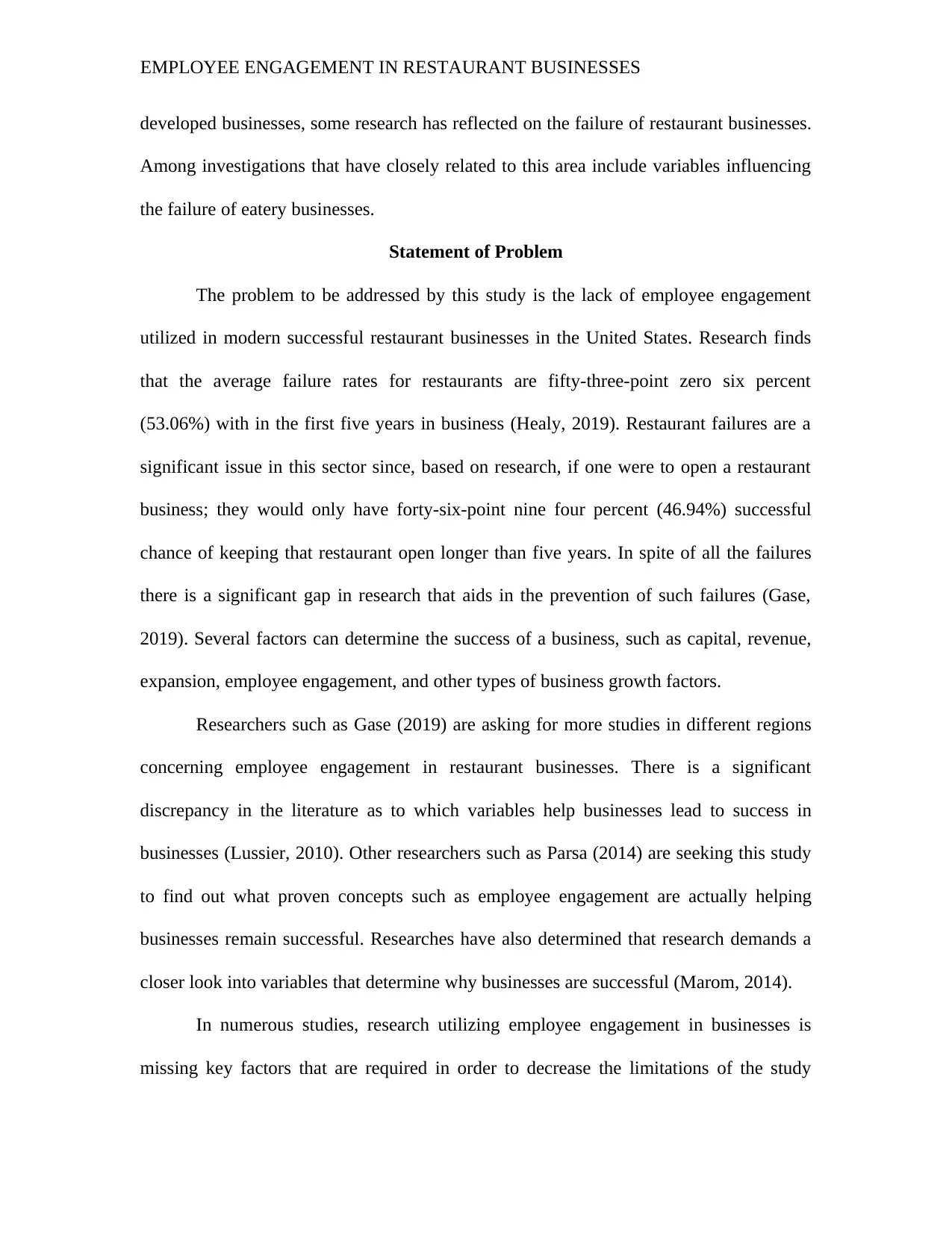
EMPLOYEE ENGAGEMENT IN RESTAURANT BUSINESSES
developed businesses, some research has reflected on the failure of restaurant businesses.
Among investigations that have closely related to this area include variables influencing
the failure of eatery businesses.
Statement of Problem
The problem to be addressed by this study is the lack of employee engagement
utilized in modern successful restaurant businesses in the United States. Research finds
that the average failure rates for restaurants are fifty-three-point zero six percent
(53.06%) with in the first five years in business (Healy, 2019). Restaurant failures are a
significant issue in this sector since, based on research, if one were to open a restaurant
business; they would only have forty-six-point nine four percent (46.94%) successful
chance of keeping that restaurant open longer than five years. In spite of all the failures
there is a significant gap in research that aids in the prevention of such failures (Gase,
2019). Several factors can determine the success of a business, such as capital, revenue,
expansion, employee engagement, and other types of business growth factors.
Researchers such as Gase (2019) are asking for more studies in different regions
concerning employee engagement in restaurant businesses. There is a significant
discrepancy in the literature as to which variables help businesses lead to success in
businesses (Lussier, 2010). Other researchers such as Parsa (2014) are seeking this study
to find out what proven concepts such as employee engagement are actually helping
businesses remain successful. Researches have also determined that research demands a
closer look into variables that determine why businesses are successful (Marom, 2014).
In numerous studies, research utilizing employee engagement in businesses is
missing key factors that are required in order to decrease the limitations of the study
developed businesses, some research has reflected on the failure of restaurant businesses.
Among investigations that have closely related to this area include variables influencing
the failure of eatery businesses.
Statement of Problem
The problem to be addressed by this study is the lack of employee engagement
utilized in modern successful restaurant businesses in the United States. Research finds
that the average failure rates for restaurants are fifty-three-point zero six percent
(53.06%) with in the first five years in business (Healy, 2019). Restaurant failures are a
significant issue in this sector since, based on research, if one were to open a restaurant
business; they would only have forty-six-point nine four percent (46.94%) successful
chance of keeping that restaurant open longer than five years. In spite of all the failures
there is a significant gap in research that aids in the prevention of such failures (Gase,
2019). Several factors can determine the success of a business, such as capital, revenue,
expansion, employee engagement, and other types of business growth factors.
Researchers such as Gase (2019) are asking for more studies in different regions
concerning employee engagement in restaurant businesses. There is a significant
discrepancy in the literature as to which variables help businesses lead to success in
businesses (Lussier, 2010). Other researchers such as Parsa (2014) are seeking this study
to find out what proven concepts such as employee engagement are actually helping
businesses remain successful. Researches have also determined that research demands a
closer look into variables that determine why businesses are successful (Marom, 2014).
In numerous studies, research utilizing employee engagement in businesses is
missing key factors that are required in order to decrease the limitations of the study
⊘ This is a preview!⊘
Do you want full access?
Subscribe today to unlock all pages.

Trusted by 1+ million students worldwide
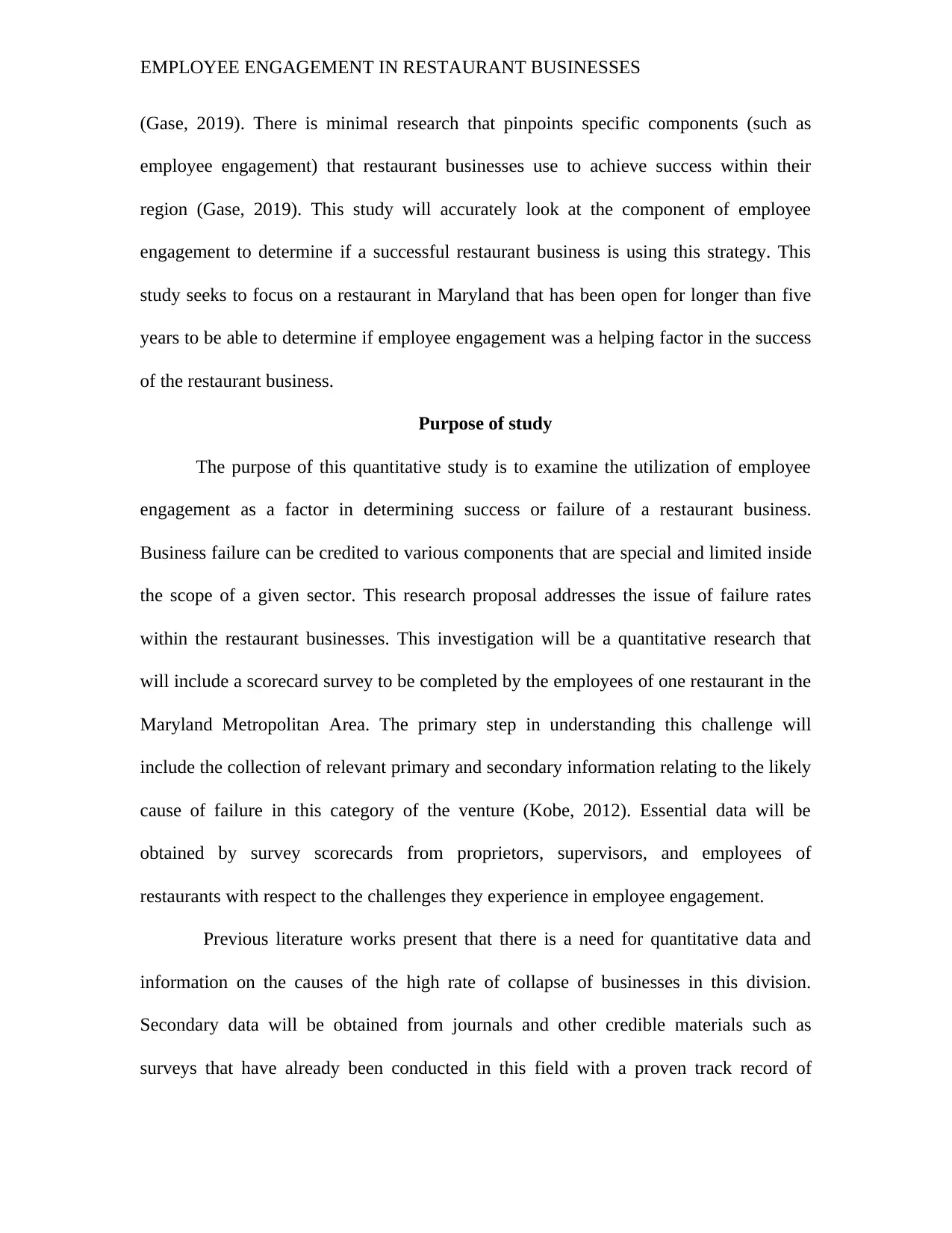
EMPLOYEE ENGAGEMENT IN RESTAURANT BUSINESSES
(Gase, 2019). There is minimal research that pinpoints specific components (such as
employee engagement) that restaurant businesses use to achieve success within their
region (Gase, 2019). This study will accurately look at the component of employee
engagement to determine if a successful restaurant business is using this strategy. This
study seeks to focus on a restaurant in Maryland that has been open for longer than five
years to be able to determine if employee engagement was a helping factor in the success
of the restaurant business.
Purpose of study
The purpose of this quantitative study is to examine the utilization of employee
engagement as a factor in determining success or failure of a restaurant business.
Business failure can be credited to various components that are special and limited inside
the scope of a given sector. This research proposal addresses the issue of failure rates
within the restaurant businesses. This investigation will be a quantitative research that
will include a scorecard survey to be completed by the employees of one restaurant in the
Maryland Metropolitan Area. The primary step in understanding this challenge will
include the collection of relevant primary and secondary information relating to the likely
cause of failure in this category of the venture (Kobe, 2012). Essential data will be
obtained by survey scorecards from proprietors, supervisors, and employees of
restaurants with respect to the challenges they experience in employee engagement.
Previous literature works present that there is a need for quantitative data and
information on the causes of the high rate of collapse of businesses in this division.
Secondary data will be obtained from journals and other credible materials such as
surveys that have already been conducted in this field with a proven track record of
(Gase, 2019). There is minimal research that pinpoints specific components (such as
employee engagement) that restaurant businesses use to achieve success within their
region (Gase, 2019). This study will accurately look at the component of employee
engagement to determine if a successful restaurant business is using this strategy. This
study seeks to focus on a restaurant in Maryland that has been open for longer than five
years to be able to determine if employee engagement was a helping factor in the success
of the restaurant business.
Purpose of study
The purpose of this quantitative study is to examine the utilization of employee
engagement as a factor in determining success or failure of a restaurant business.
Business failure can be credited to various components that are special and limited inside
the scope of a given sector. This research proposal addresses the issue of failure rates
within the restaurant businesses. This investigation will be a quantitative research that
will include a scorecard survey to be completed by the employees of one restaurant in the
Maryland Metropolitan Area. The primary step in understanding this challenge will
include the collection of relevant primary and secondary information relating to the likely
cause of failure in this category of the venture (Kobe, 2012). Essential data will be
obtained by survey scorecards from proprietors, supervisors, and employees of
restaurants with respect to the challenges they experience in employee engagement.
Previous literature works present that there is a need for quantitative data and
information on the causes of the high rate of collapse of businesses in this division.
Secondary data will be obtained from journals and other credible materials such as
surveys that have already been conducted in this field with a proven track record of
Paraphrase This Document
Need a fresh take? Get an instant paraphrase of this document with our AI Paraphraser
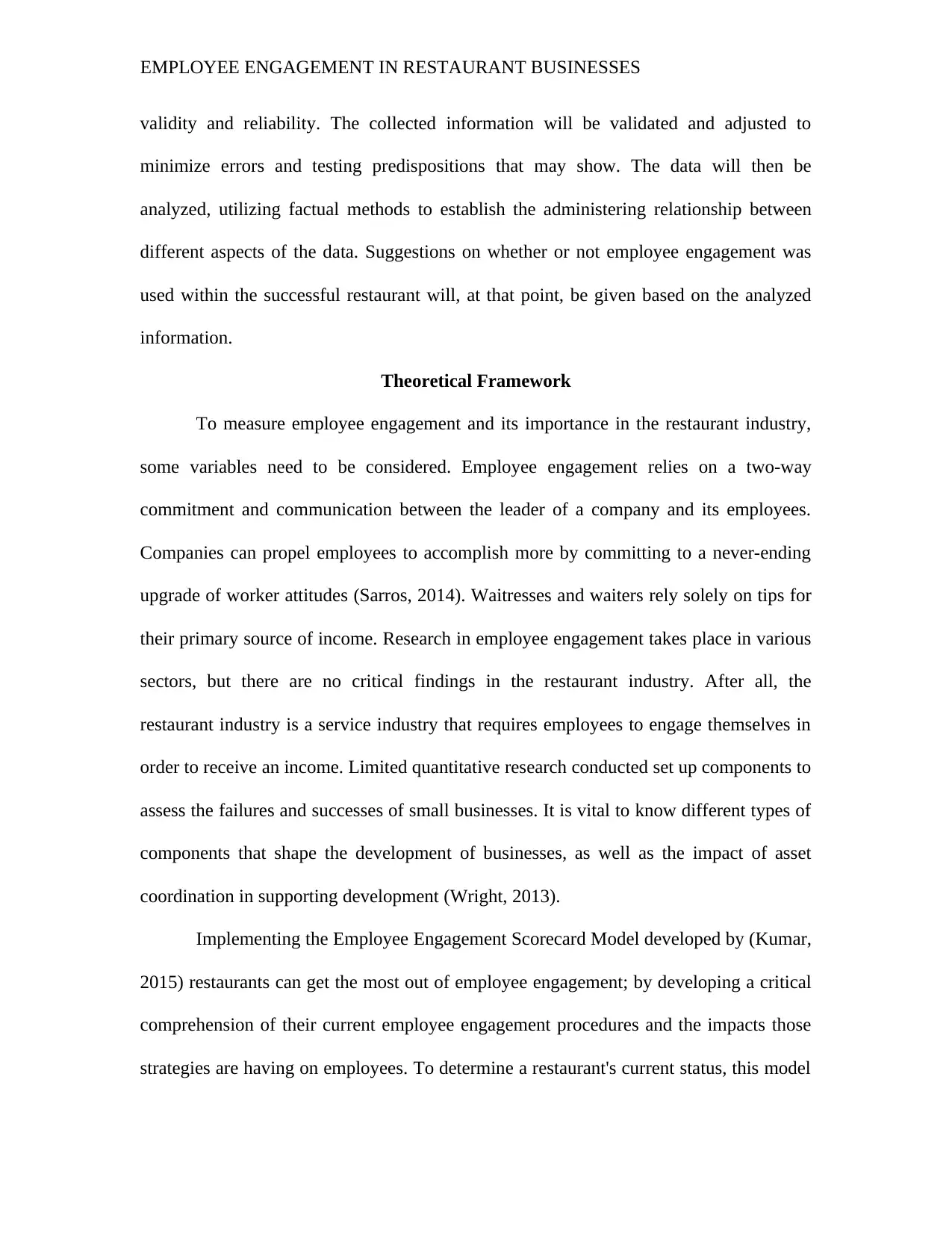
EMPLOYEE ENGAGEMENT IN RESTAURANT BUSINESSES
validity and reliability. The collected information will be validated and adjusted to
minimize errors and testing predispositions that may show. The data will then be
analyzed, utilizing factual methods to establish the administering relationship between
different aspects of the data. Suggestions on whether or not employee engagement was
used within the successful restaurant will, at that point, be given based on the analyzed
information.
Theoretical Framework
To measure employee engagement and its importance in the restaurant industry,
some variables need to be considered. Employee engagement relies on a two-way
commitment and communication between the leader of a company and its employees.
Companies can propel employees to accomplish more by committing to a never-ending
upgrade of worker attitudes (Sarros, 2014). Waitresses and waiters rely solely on tips for
their primary source of income. Research in employee engagement takes place in various
sectors, but there are no critical findings in the restaurant industry. After all, the
restaurant industry is a service industry that requires employees to engage themselves in
order to receive an income. Limited quantitative research conducted set up components to
assess the failures and successes of small businesses. It is vital to know different types of
components that shape the development of businesses, as well as the impact of asset
coordination in supporting development (Wright, 2013).
Implementing the Employee Engagement Scorecard Model developed by (Kumar,
2015) restaurants can get the most out of employee engagement; by developing a critical
comprehension of their current employee engagement procedures and the impacts those
strategies are having on employees. To determine a restaurant's current status, this model
validity and reliability. The collected information will be validated and adjusted to
minimize errors and testing predispositions that may show. The data will then be
analyzed, utilizing factual methods to establish the administering relationship between
different aspects of the data. Suggestions on whether or not employee engagement was
used within the successful restaurant will, at that point, be given based on the analyzed
information.
Theoretical Framework
To measure employee engagement and its importance in the restaurant industry,
some variables need to be considered. Employee engagement relies on a two-way
commitment and communication between the leader of a company and its employees.
Companies can propel employees to accomplish more by committing to a never-ending
upgrade of worker attitudes (Sarros, 2014). Waitresses and waiters rely solely on tips for
their primary source of income. Research in employee engagement takes place in various
sectors, but there are no critical findings in the restaurant industry. After all, the
restaurant industry is a service industry that requires employees to engage themselves in
order to receive an income. Limited quantitative research conducted set up components to
assess the failures and successes of small businesses. It is vital to know different types of
components that shape the development of businesses, as well as the impact of asset
coordination in supporting development (Wright, 2013).
Implementing the Employee Engagement Scorecard Model developed by (Kumar,
2015) restaurants can get the most out of employee engagement; by developing a critical
comprehension of their current employee engagement procedures and the impacts those
strategies are having on employees. To determine a restaurant's current status, this model
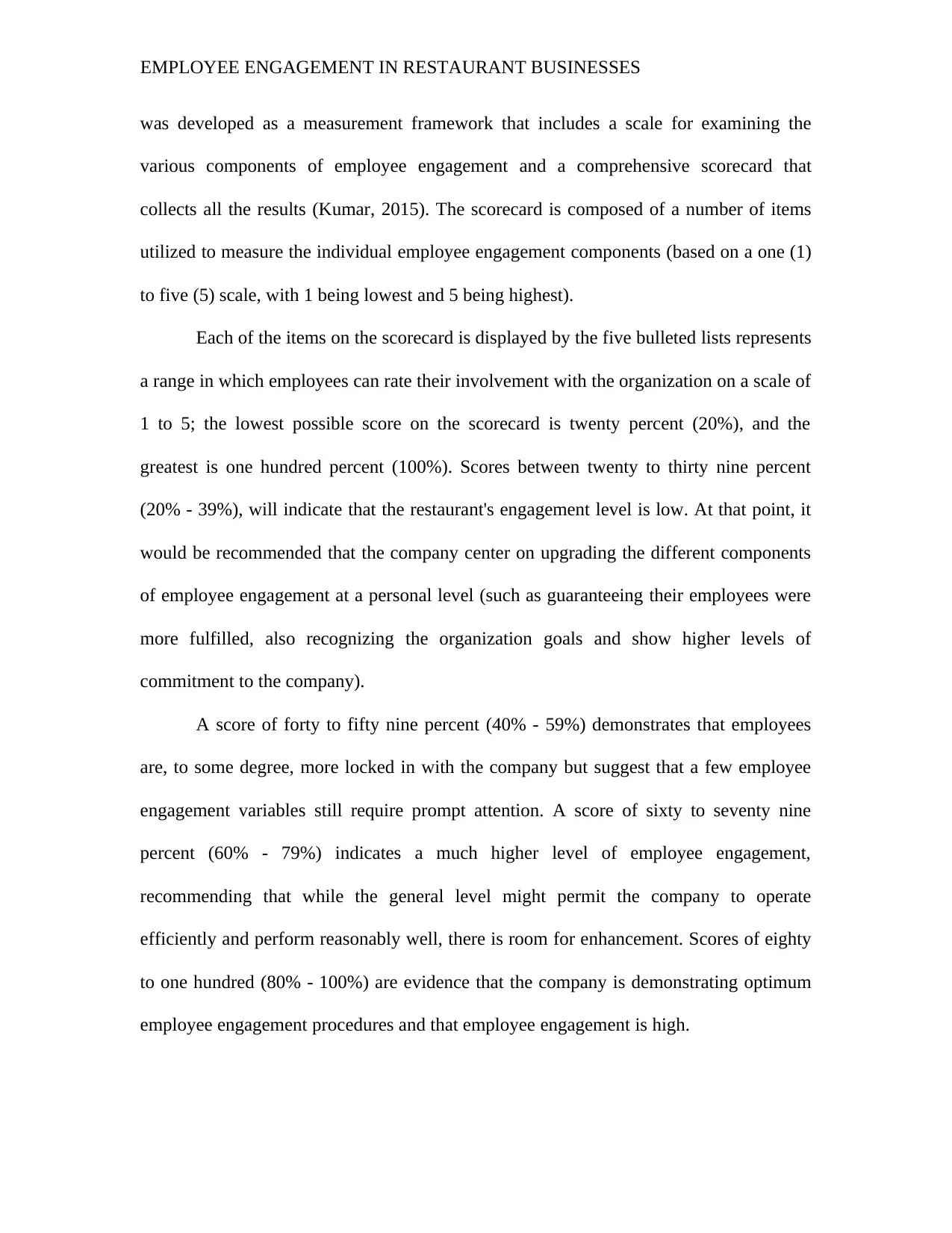
EMPLOYEE ENGAGEMENT IN RESTAURANT BUSINESSES
was developed as a measurement framework that includes a scale for examining the
various components of employee engagement and a comprehensive scorecard that
collects all the results (Kumar, 2015). The scorecard is composed of a number of items
utilized to measure the individual employee engagement components (based on a one (1)
to five (5) scale, with 1 being lowest and 5 being highest).
Each of the items on the scorecard is displayed by the five bulleted lists represents
a range in which employees can rate their involvement with the organization on a scale of
1 to 5; the lowest possible score on the scorecard is twenty percent (20%), and the
greatest is one hundred percent (100%). Scores between twenty to thirty nine percent
(20% - 39%), will indicate that the restaurant's engagement level is low. At that point, it
would be recommended that the company center on upgrading the different components
of employee engagement at a personal level (such as guaranteeing their employees were
more fulfilled, also recognizing the organization goals and show higher levels of
commitment to the company).
A score of forty to fifty nine percent (40% - 59%) demonstrates that employees
are, to some degree, more locked in with the company but suggest that a few employee
engagement variables still require prompt attention. A score of sixty to seventy nine
percent (60% - 79%) indicates a much higher level of employee engagement,
recommending that while the general level might permit the company to operate
efficiently and perform reasonably well, there is room for enhancement. Scores of eighty
to one hundred (80% - 100%) are evidence that the company is demonstrating optimum
employee engagement procedures and that employee engagement is high.
was developed as a measurement framework that includes a scale for examining the
various components of employee engagement and a comprehensive scorecard that
collects all the results (Kumar, 2015). The scorecard is composed of a number of items
utilized to measure the individual employee engagement components (based on a one (1)
to five (5) scale, with 1 being lowest and 5 being highest).
Each of the items on the scorecard is displayed by the five bulleted lists represents
a range in which employees can rate their involvement with the organization on a scale of
1 to 5; the lowest possible score on the scorecard is twenty percent (20%), and the
greatest is one hundred percent (100%). Scores between twenty to thirty nine percent
(20% - 39%), will indicate that the restaurant's engagement level is low. At that point, it
would be recommended that the company center on upgrading the different components
of employee engagement at a personal level (such as guaranteeing their employees were
more fulfilled, also recognizing the organization goals and show higher levels of
commitment to the company).
A score of forty to fifty nine percent (40% - 59%) demonstrates that employees
are, to some degree, more locked in with the company but suggest that a few employee
engagement variables still require prompt attention. A score of sixty to seventy nine
percent (60% - 79%) indicates a much higher level of employee engagement,
recommending that while the general level might permit the company to operate
efficiently and perform reasonably well, there is room for enhancement. Scores of eighty
to one hundred (80% - 100%) are evidence that the company is demonstrating optimum
employee engagement procedures and that employee engagement is high.
⊘ This is a preview!⊘
Do you want full access?
Subscribe today to unlock all pages.

Trusted by 1+ million students worldwide
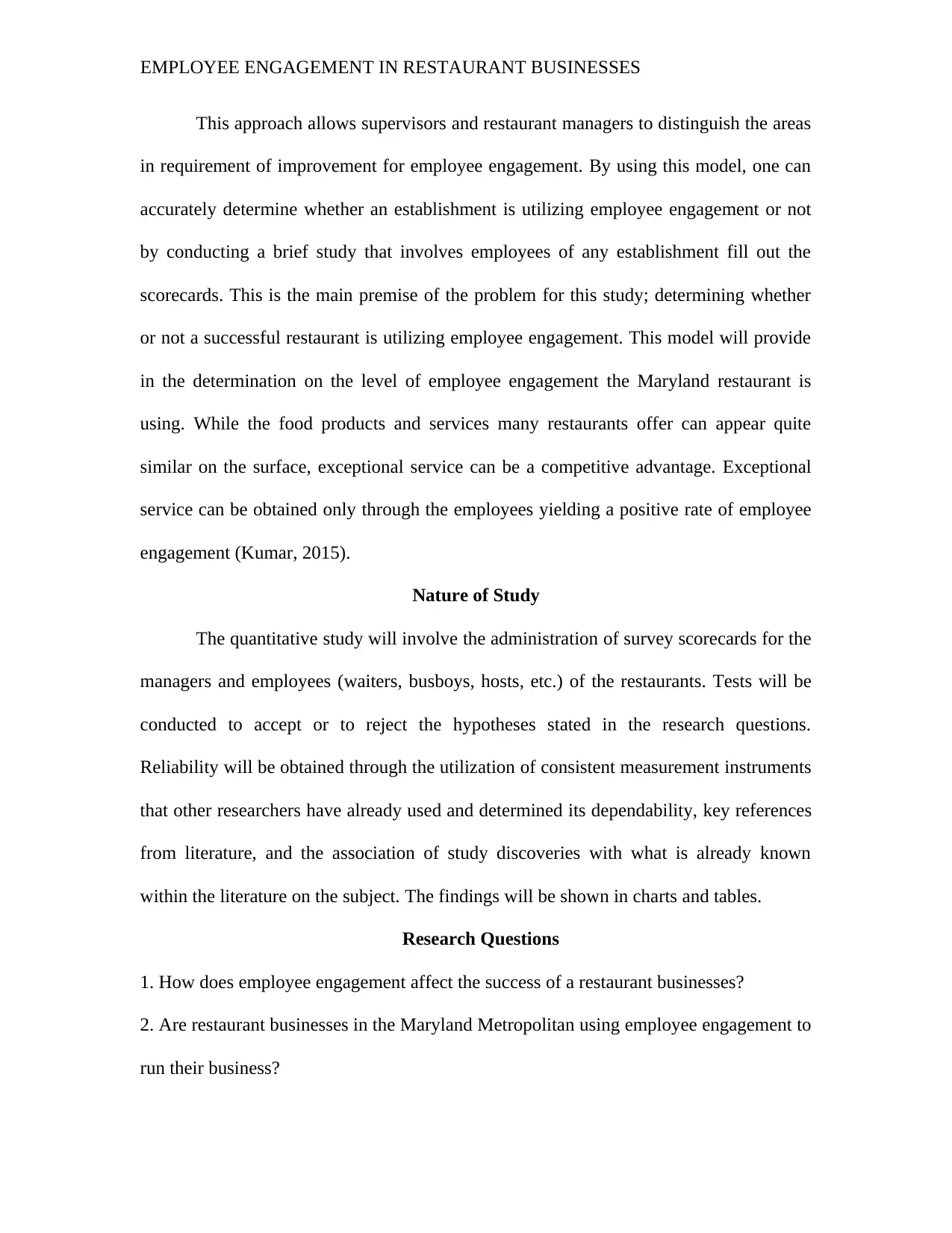
EMPLOYEE ENGAGEMENT IN RESTAURANT BUSINESSES
This approach allows supervisors and restaurant managers to distinguish the areas
in requirement of improvement for employee engagement. By using this model, one can
accurately determine whether an establishment is utilizing employee engagement or not
by conducting a brief study that involves employees of any establishment fill out the
scorecards. This is the main premise of the problem for this study; determining whether
or not a successful restaurant is utilizing employee engagement. This model will provide
in the determination on the level of employee engagement the Maryland restaurant is
using. While the food products and services many restaurants offer can appear quite
similar on the surface, exceptional service can be a competitive advantage. Exceptional
service can be obtained only through the employees yielding a positive rate of employee
engagement (Kumar, 2015).
Nature of Study
The quantitative study will involve the administration of survey scorecards for the
managers and employees (waiters, busboys, hosts, etc.) of the restaurants. Tests will be
conducted to accept or to reject the hypotheses stated in the research questions.
Reliability will be obtained through the utilization of consistent measurement instruments
that other researchers have already used and determined its dependability, key references
from literature, and the association of study discoveries with what is already known
within the literature on the subject. The findings will be shown in charts and tables.
Research Questions
1. How does employee engagement affect the success of a restaurant businesses?
2. Are restaurant businesses in the Maryland Metropolitan using employee engagement to
run their business?
This approach allows supervisors and restaurant managers to distinguish the areas
in requirement of improvement for employee engagement. By using this model, one can
accurately determine whether an establishment is utilizing employee engagement or not
by conducting a brief study that involves employees of any establishment fill out the
scorecards. This is the main premise of the problem for this study; determining whether
or not a successful restaurant is utilizing employee engagement. This model will provide
in the determination on the level of employee engagement the Maryland restaurant is
using. While the food products and services many restaurants offer can appear quite
similar on the surface, exceptional service can be a competitive advantage. Exceptional
service can be obtained only through the employees yielding a positive rate of employee
engagement (Kumar, 2015).
Nature of Study
The quantitative study will involve the administration of survey scorecards for the
managers and employees (waiters, busboys, hosts, etc.) of the restaurants. Tests will be
conducted to accept or to reject the hypotheses stated in the research questions.
Reliability will be obtained through the utilization of consistent measurement instruments
that other researchers have already used and determined its dependability, key references
from literature, and the association of study discoveries with what is already known
within the literature on the subject. The findings will be shown in charts and tables.
Research Questions
1. How does employee engagement affect the success of a restaurant businesses?
2. Are restaurant businesses in the Maryland Metropolitan using employee engagement to
run their business?
Paraphrase This Document
Need a fresh take? Get an instant paraphrase of this document with our AI Paraphraser
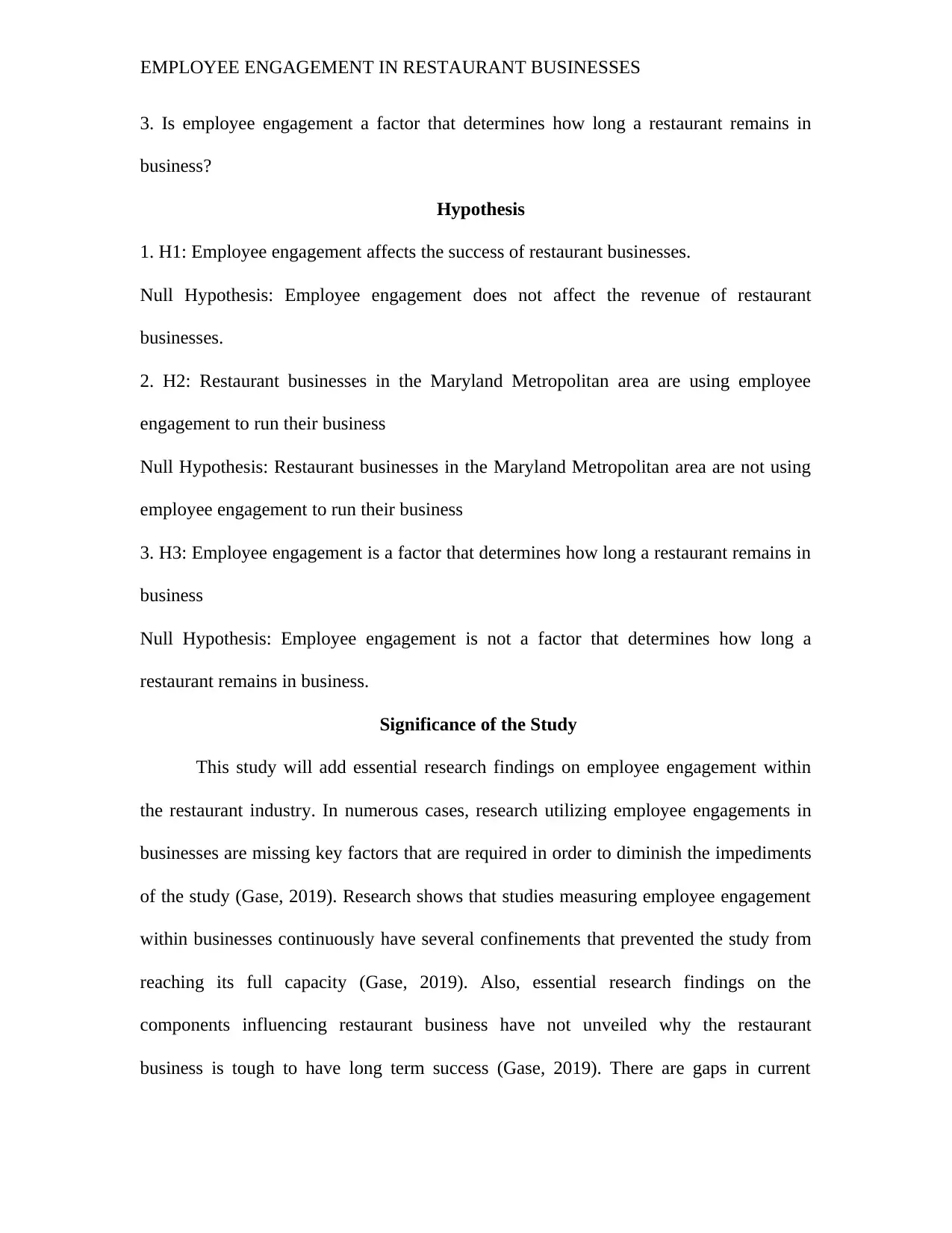
EMPLOYEE ENGAGEMENT IN RESTAURANT BUSINESSES
3. Is employee engagement a factor that determines how long a restaurant remains in
business?
Hypothesis
1. H1: Employee engagement affects the success of restaurant businesses.
Null Hypothesis: Employee engagement does not affect the revenue of restaurant
businesses.
2. H2: Restaurant businesses in the Maryland Metropolitan area are using employee
engagement to run their business
Null Hypothesis: Restaurant businesses in the Maryland Metropolitan area are not using
employee engagement to run their business
3. H3: Employee engagement is a factor that determines how long a restaurant remains in
business
Null Hypothesis: Employee engagement is not a factor that determines how long a
restaurant remains in business.
Significance of the Study
This study will add essential research findings on employee engagement within
the restaurant industry. In numerous cases, research utilizing employee engagements in
businesses are missing key factors that are required in order to diminish the impediments
of the study (Gase, 2019). Research shows that studies measuring employee engagement
within businesses continuously have several confinements that prevented the study from
reaching its full capacity (Gase, 2019). Also, essential research findings on the
components influencing restaurant business have not unveiled why the restaurant
business is tough to have long term success (Gase, 2019). There are gaps in current
3. Is employee engagement a factor that determines how long a restaurant remains in
business?
Hypothesis
1. H1: Employee engagement affects the success of restaurant businesses.
Null Hypothesis: Employee engagement does not affect the revenue of restaurant
businesses.
2. H2: Restaurant businesses in the Maryland Metropolitan area are using employee
engagement to run their business
Null Hypothesis: Restaurant businesses in the Maryland Metropolitan area are not using
employee engagement to run their business
3. H3: Employee engagement is a factor that determines how long a restaurant remains in
business
Null Hypothesis: Employee engagement is not a factor that determines how long a
restaurant remains in business.
Significance of the Study
This study will add essential research findings on employee engagement within
the restaurant industry. In numerous cases, research utilizing employee engagements in
businesses are missing key factors that are required in order to diminish the impediments
of the study (Gase, 2019). Research shows that studies measuring employee engagement
within businesses continuously have several confinements that prevented the study from
reaching its full capacity (Gase, 2019). Also, essential research findings on the
components influencing restaurant business have not unveiled why the restaurant
business is tough to have long term success (Gase, 2019). There are gaps in current
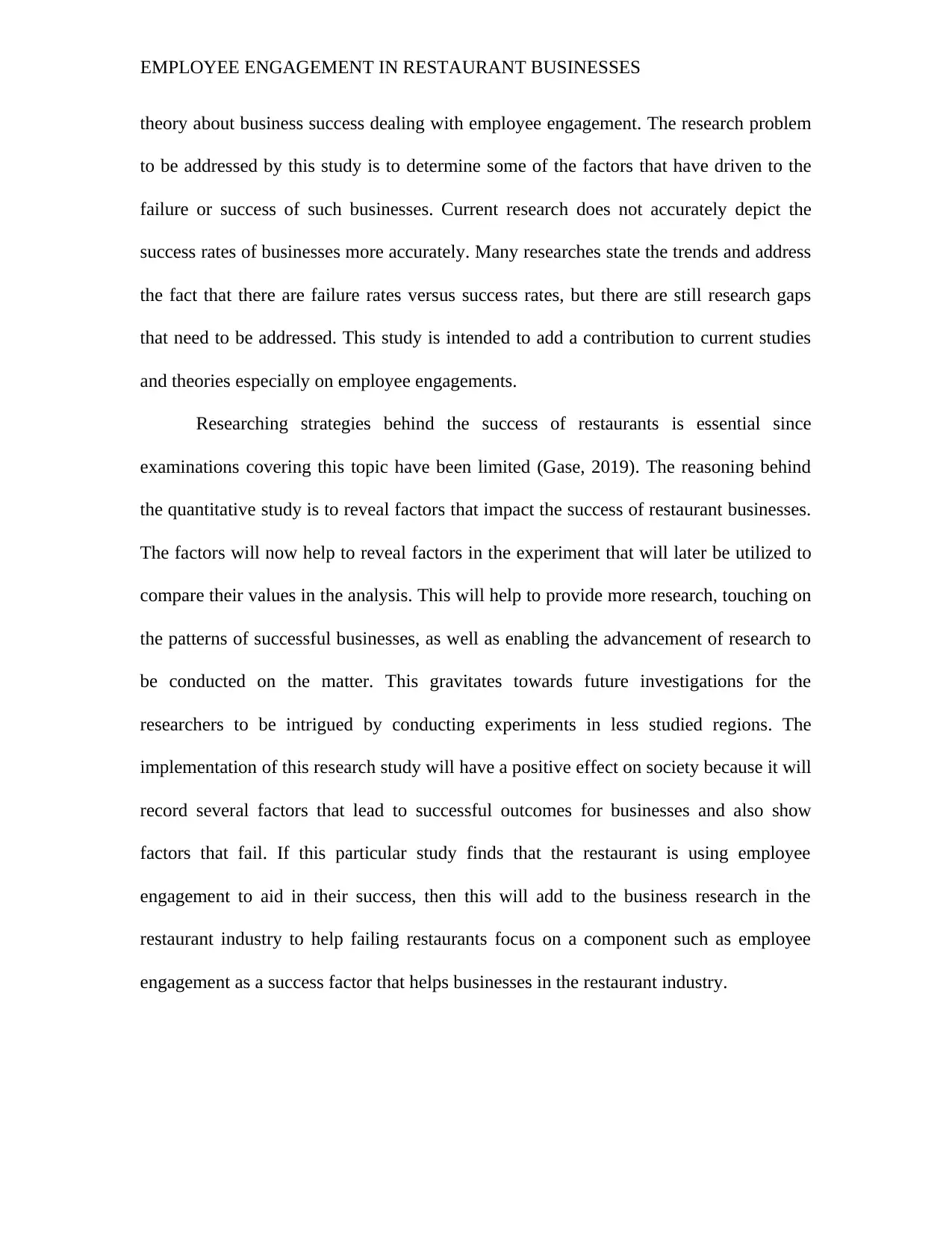
EMPLOYEE ENGAGEMENT IN RESTAURANT BUSINESSES
theory about business success dealing with employee engagement. The research problem
to be addressed by this study is to determine some of the factors that have driven to the
failure or success of such businesses. Current research does not accurately depict the
success rates of businesses more accurately. Many researches state the trends and address
the fact that there are failure rates versus success rates, but there are still research gaps
that need to be addressed. This study is intended to add a contribution to current studies
and theories especially on employee engagements.
Researching strategies behind the success of restaurants is essential since
examinations covering this topic have been limited (Gase, 2019). The reasoning behind
the quantitative study is to reveal factors that impact the success of restaurant businesses.
The factors will now help to reveal factors in the experiment that will later be utilized to
compare their values in the analysis. This will help to provide more research, touching on
the patterns of successful businesses, as well as enabling the advancement of research to
be conducted on the matter. This gravitates towards future investigations for the
researchers to be intrigued by conducting experiments in less studied regions. The
implementation of this research study will have a positive effect on society because it will
record several factors that lead to successful outcomes for businesses and also show
factors that fail. If this particular study finds that the restaurant is using employee
engagement to aid in their success, then this will add to the business research in the
restaurant industry to help failing restaurants focus on a component such as employee
engagement as a success factor that helps businesses in the restaurant industry.
theory about business success dealing with employee engagement. The research problem
to be addressed by this study is to determine some of the factors that have driven to the
failure or success of such businesses. Current research does not accurately depict the
success rates of businesses more accurately. Many researches state the trends and address
the fact that there are failure rates versus success rates, but there are still research gaps
that need to be addressed. This study is intended to add a contribution to current studies
and theories especially on employee engagements.
Researching strategies behind the success of restaurants is essential since
examinations covering this topic have been limited (Gase, 2019). The reasoning behind
the quantitative study is to reveal factors that impact the success of restaurant businesses.
The factors will now help to reveal factors in the experiment that will later be utilized to
compare their values in the analysis. This will help to provide more research, touching on
the patterns of successful businesses, as well as enabling the advancement of research to
be conducted on the matter. This gravitates towards future investigations for the
researchers to be intrigued by conducting experiments in less studied regions. The
implementation of this research study will have a positive effect on society because it will
record several factors that lead to successful outcomes for businesses and also show
factors that fail. If this particular study finds that the restaurant is using employee
engagement to aid in their success, then this will add to the business research in the
restaurant industry to help failing restaurants focus on a component such as employee
engagement as a success factor that helps businesses in the restaurant industry.
⊘ This is a preview!⊘
Do you want full access?
Subscribe today to unlock all pages.

Trusted by 1+ million students worldwide
1 out of 27
Related Documents
Your All-in-One AI-Powered Toolkit for Academic Success.
+13062052269
info@desklib.com
Available 24*7 on WhatsApp / Email
![[object Object]](/_next/static/media/star-bottom.7253800d.svg)
Unlock your academic potential
Copyright © 2020–2025 A2Z Services. All Rights Reserved. Developed and managed by ZUCOL.





